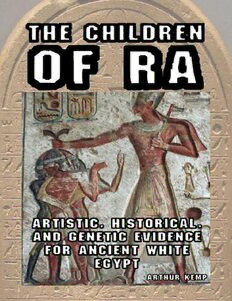
The Children of Ra PDF
Preview The Children of Ra
By Arthur Kemp B.A. (Pol. Sci., Intl. Pol., Pub. Admin.) Ostara Publications The Children of Ra: Artistic, Historical and Genetic Evidence for Ancient White Egypt By Arthur Kemp Ostara Publications © 2012 Other books by Arthur Kemp March of the Titans: The Complete History of the White Race The Immigration Invasion: How Third World Immigration is Destroying the First World and What Must be Done to Stop it Jihad: Islam’s 1,300 Year War on Western Civilization Four Flags: History, DNA and the Right to Existence of the Indigenous People of Britain Folk and Nation – Underpinning the Ethnostate The Lie of Apartheid and other true stories from Southern Africa Victory or Violence: The Story of the AWB of South Africa All available from Ostara Publications www.ostarapublications.com Ramesses II Contents Chapter 1. Introduction Chapter 2. Timeline of Ancient Egypt Chapter 3. The Origins of the Ancient Egyptians Chapter 4. Ginger—the Oldest Mummy Chapter 5. Statues and Paintings—the Artistic Evidence Chapter 6. Faces of the Dead—Mummies Chapter 7. The Nine Bows—the Enemies of Egypt among Tutankhamun’s Treasure Chapter 8. Writing on the Wall—Other Races as Portrayed in Egyptian Art Chapter 9. Nubian Pharaohs—the End of Ancient Egypt Chapter 10. Carved in Stone—Egyptian Writings about Their Enemies Chapter 11. DNA—the Truth Leaks Out Chapter 12. Conclusion Chapter 1. Introduction “There can be no doubt that the Colchians are an Egyptian race . . . My own conjectures were founded, first, on the fact that they are black-skinned and have woolly hair . . .” The Histories, Book II (Euterpe), by Herodotus. Herodotus’s famous quote about black-skinned and woolly-haired Egyptians is one of the more commonly-used “arguments” one will hear when doing research about the racial origins of the ancient Egyptians. Herodotus, known as the “father of history” for his ground-breaking historical work, The Histories, written between the years 450 and 420 BC, explained how he travelled to Egypt for those personal observations. For many years, scholars believed that the ancient Egyptians—those who presided over the building of the Great Pyramids and other monuments of that civilization—were either Arabic or Semitic in origin. For example, French historian Constantin-François Chasseboeuf (1757–1820), writing in his work Principes Physiques de la Morale, Déduits de l’Organisation de l’Homme et de l’Univers, said that the “Copts are the proper representatives of the Ancient Egyptians” due to their “jaundiced and fumed skin, which is neither Greek nor Arab, their full faces, their puffy eyes, their crushed noses, and their thick lips.” Other scholars of the Middle Ages attempted to explain the origin of ancient Egyptians by suggesting that they were the descendants of the “children of Ham.” This view held sway until the advent of the “Dynastic Race” theory, whose leading proponent was British Egyptologist Sir William Matthew Flinders Petrie (1853–1942). Petrie conducted the first proper scientific and forensic examination of artwork, mummies, and inscriptions from Ancient Egypt, concluding that there were at least three different races present in Egypt: Caucasian, Semitic, and Nubian (African). Furthermore, he said, the historical evidence indicated that the first proper civilization in Egypt had been the result of an invasion of a founding Caucasian race (what he called the “Dynastic Race”), from the north, and specifically from Mesopotamia. Sir William Matthew Flinders Petrie. This theory fit the timing of the rise of both Mesopotamian and Egyptian civilizations, and explained a number of cultural similarities between the two, such as pictographic writing and (at first) the building of step-pyramids. Petrie’s explanation, backed by notes, photographs, and evidence (today kept in the archives of the Petrie Museum of Egyptology at University College, London), was so convincing that it became the standard theory for the origin of the ancient Egyptians right up to the 1950s and 1960s. With the rise of African nationalism after World War II, and the subsequent decolonization of the Third World, Afrocentrists laid claim to Egypt. In particular, the Senegalese writer Cheikh Anta Diop produced several works which claimed that the Egyptians were in fact “black Africans.” Other Afrocentrists chimed in, including the Cornell University academic Martin Bernal. The latter faced fierce opposition from Mary Lefkowitz at Wellesley College, and these two individuals dominated the debate, at least in the US, for many decades. The Afrocentric view has come to be more widely accepted, mostly because of the active connivance of ill-informed mass media outlets who all too often have accepted portrayals of ancient Egyptian society as black without doing any serious research into the topic. As such, “Black History” exhibits and celebrations nowadays almost all make the claim that ancient Egypt was black in origin, and, seemingly, no one dares question this for fear of “giving offense.” So was ancient Egypt black, as the modern Afrocentrists would have the world believe? The images, text, and DNA data contained in this book should, the author believes, provide the answer.
